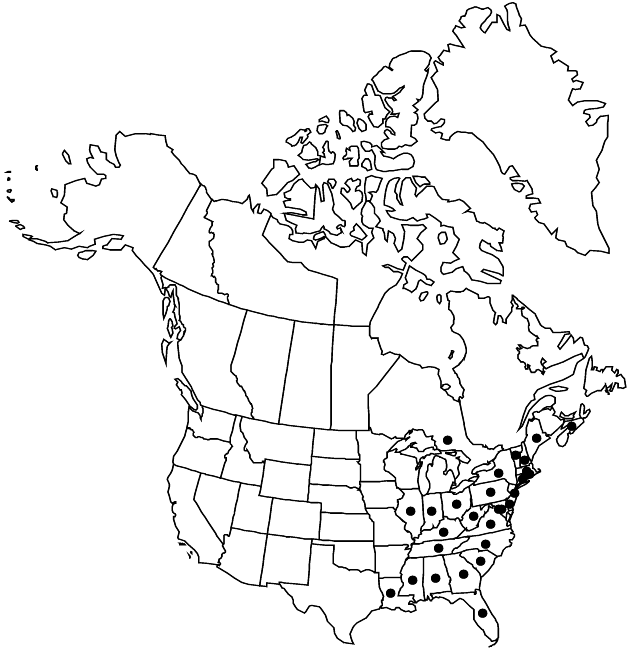Symphyotrichum undulatum
Phytologia 77: 293. 1995.
Perennials, 30–160 cm, cespitose; short-rhizomatous or with branched, woody caudices. Stems 1–3+, erect (straight, brittle), hirtellous to glabrescent proximally to densely hirtellous distally. Leaves thin, margins scabrous, abaxial faces hirtellous, densely so on midveins, adaxial usually scabrous, sometimes strigose or hirsute, rarely glabrate; basal withering by flowering (sometimes new winter rosette developing), petiolate (petioles purplish, narrowly winged, bases dilated and sheathing, hirsute), blades oblong-ovate or ovate to widely ovate, (10–)35–60(–140) × (10–)15–70 mm, bases usually cordate or subcordate to rounded, sometimes attenuate, margins shallowly crenate-serrate to subentire, apices obtuse or rounded, mucronulate; proximalmost cauline withering by flowering, proximal persistent, winged-petiolate, distally more widely winged or ± sessile, wings widening abruptly at strongly auriculate-clasping petiolar bases, blades ovate to lanceolate, 30–120(–140) × (10–)20–50 mm, reduced distally, bases cordate- or auriculate-clasping (sessile), margins crenate-serrate or entire, apices acute or acuminate, mucronate; distal sessile, blades lance-ovate to oblong or lanceolate to linear-lanceolate, sometimes pandurate (branch leaves ovate to lanceolate, sharply smaller), 4–100 × 0.5–26 mm, reduced distally, bases ± clasping, sheathing, margins serrulate or entire, apices acute or acuminate to long-acuminate. Heads in open, narrow to wide paniculiform arrays, branches widely spreading, divaricate to ascending, sometimes secund, ± densely leafy. Peduncles well developed, 0.3–3(–5) cm, branches to 10 cm, spreading, bracteate, densely hirtellous to strigillose, bracts 3–10+, firm, appressed, subulate (2–3 mm), grading into phyllaries. Involucres campanulate to cylindro-campanulate, 3.8–5.5 mm. Phyllaries in 4–5(–6) series, appressed or outer spreading, oblong-lanceolate (outer) to linear-oblanceolate (inner) or linear (innermost), strongly unequal, bases indurate 1/2–2/3, margins scarious, erose, hyaline, ciliolate, green zones diamond-shaped to lanceolate, apices acute to acuminate or obtuse, often ± involute, often mucronulate, sometimes tips purplish, abaxial faces hirsutulous, adaxial sparsely so distally. Ray florets 12–16(–25); corollas usually blue to purple, sometimes lilac, laminae 6–12 × 1.4–2.5 mm. Disc florets 15–22(–25); corollas cream or light yellow becoming purple, 4–5.8 mm, tubes slightly shorter than funnelform throats, lobes lanceolate, 0.5–0.9 mm. Cypselae dull purple to light brown or tan, oblong-obovoid, compressed, 1.7–2.2 mm, 3–4-nerved, faces strigillose; pappi cream or rose-tinged, 3.5–5 mm. 2n = 16, 32.
Phenology: Flowering Aug–Oct.
Habitat: Dry or well-drained, loamy or rocky soils, open decidous woods, borders, clearings, dry hammocks, sandhills, open-wooded bluffs underlain by sandstone or limestone
Elevation: 200–1500 m
Distribution

N.S., Ont., Ala., Conn., Del., D.C., Fla., Ga., Ill., Ind., Ky., La., Maine, Md., Mass., Miss., N.H., N.J., N.Y., N.C., Ohio, Pa., R.I., S.C., Tenn., Vt., Va., W.Va.
Discussion
Symphyotrichum undulatum is of conservation concern in Illinois and Nova Scotia. Hybridization with S. drummondii and S. oolentangiense has been by reported by A. G. Jones (1989), but some specimens so annotated represent phenotypic variation of S. undulatum. Symphyotrichum undulatum is sometimes confused with members of the S. patens complex due to its auriculate-clasping, more or less pandurifom cauline leaves.
Selected References
None.